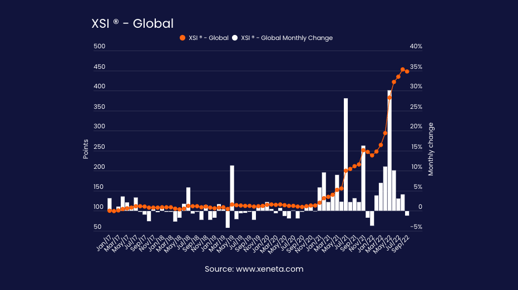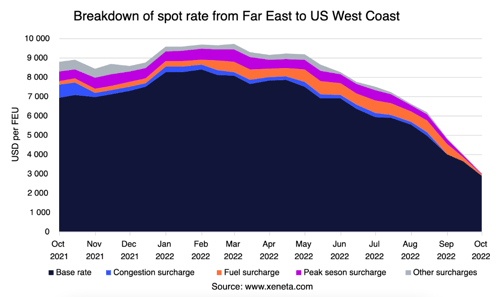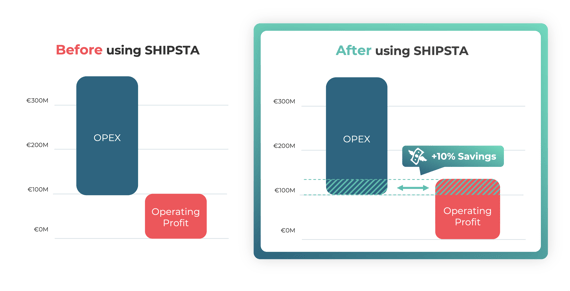From scarce and extremely pricey to balanced and more favorable, the freight market has changed drastically in recent months.
The global drop in freight rates is a game changer for securing better prices. But is your strategy ready to make the most of the current market?
The domino effect of falling freight rates finally hits long-term contracts
The global slump in consumer demand has led to a 20% drop in the overall ocean booking volume. This shift has drastically driven down spot rates, leading to an almost unusual market situation, spot prices being lower than contract rates.
While spot prices have been sinking over the last months, long-term rates have remained stubbornly high, mainly due to the fear of further disruptions and volatile oil prices. But this misaligned scenario of falling spot rates and rising long-term prices has finally come to an end. As we forecasted in June, when spot rates go down, contracts always follow. And that’s what has just happened.
For the first time since January 2022, the global XSI® index reported the first month-on-month decline in long-term contracts in September, falling by 1.1%. And this won’t be the last according to Xeneta – SHIPSTA’s partner for real-time freight benchmarking.

Credits: Xeneta
Lower prices are always good news for shippers. But this slight drop still leaves an unbalanced outlook between the spot and contract markets. The actual change will come from long-term contract negotiations in exchange for delivering more volumes – which is the factor behind this first fall and will pave the way for further declines next tender season.
This new market situation (so long awaited by logistics managers and CFOs) is once again a game changer for building a winning freight procurement strategy during this Q4. Now the key question is… How big is the impact the declining market could have on shippers' bottom-line before the end of the year?
The answer is simple. It all will depend on the agility of the procurement teams. Because in logistics, as in the stock market, only those who act quickly will come out on top.
Shippers take the driver’s seat in negotiations. Falling ocean prices are a golden opportunity for profitability and return on investment.
Supply chain costs have gone through the roof in the last years, and freight transport was the biggest contributor to this. Shippers have been forced to accept sky-high prices simply to get their cargo moving in a capacity-scarce market.
For the first time in years, they are now back in the driver’s seat in negotiations.
The recent drop in ocean rates brings a huge opportunity to optimize financial targets through transport savings. And considering that 90% of the world's freight transport moves by waves, we’re talking about significant potential savings.
 Credits: Xeneta
Credits: Xeneta
Efficient freight management has a direct impact on business profitability, and even more so given the current market.
So, with this winning opportunity on the table, what could be holding procurement teams back to negotiate better rates?
The reality is that many procurement teams are still unprepared to respond effectively to market changes. They experience the hassle of managing manually thousands of rates on Excel spreadsheets and negotiating with their suppliers through calls and emails. According to Gartner, procurement delays eliminate 1% to 2% of potential savings and add significant costs.
In the midst of a logistics digitization wave, leading enterprises are already leveraging digital freight procurement technology to maximize their profitability, securing up to 10% of the revenue from operations thanks to transport savings.
 Savings applicable to OPEX or COGS, depending on the industry and individual enterprises' accounting standards.
Savings applicable to OPEX or COGS, depending on the industry and individual enterprises' accounting standards.
These potential savings are actionable for all shippers. Just by scheduling a free consultation with SHIPSTA’s industry experts by end of 2022, you can see how much you could save on your bottom line by optimizing transportation costs and how to do it.
Given the massive rate drop this year, the logistics teams empowered with the right technology to digitize procurement workflows will have the competitive advantage to get the best contracts and achieve a fast return on investment.
4 ways to build a winning strategy when freight rates are falling
As consumer buying falls, shipping companies have less cargo to move and must compete to lock-in volumes to cope with lower global demand. Shippers can now finally negotiate stronger rates, both to finish the year strong and to secure a competitive 2023.
To reap the best rewards in this new market, shippers must reorient their strategy and focus on the following key actions:
- Adjusting long-term contracts – This tender season, shippers have an ace up their sleeve to negotiate their contracts (or even extend their negotiations) to see how they can adjust their agreements and bring them in line with current spot rates.
- Tendering at the right time – With the spot market declining, short-term tenders will lead the procurement strategies in 2023. So, shippers must track their key lanes to secure lower freight rates when prices start to fall.
- Expanding carrier networks – Gone are the days shippers need to be loyal to secure transport. Now’s the time to shop around to find the best rates and decide on much more complex variables such as CO2 emissions or performance.
- Managing the risk of fuel volatility – Rising fuel prices are one of the main hurdles keeping freight rates above the pre-covid scenario and conditioning extra costs. Procurement teams should get their fuel rates automatically updated to track all prices and get rates approved centrally, so they can react faster to any disruption.
Something we’ve learned over the last few years is that disruptions in the logistics market are here to stay. It seems that the market is shifting more in favor of shippers. But the next shake-up could be just around the corner.
Climate change, oil and gas volatility and economic fluctuations will keep logistics teams on their toes for the next years.
Right now, shippers have the wind at their backs. How long that will last is uncertain. That's why acting at the right time becomes a matter of winning or losing in the current market. If shippers want to succeed, innovating their strategy is essential.
Industry leaders are adopting digital freight procurement technology to:
- Track the fast-moving market and tender at the perfect moment
- Reduce tendering time from hours to just minutes
- Manage risk with suppliers
- Save significant costs
- Gain unique insights through data transparency
This becomes a priority for procurement managers, not only to close the year strong, but also to avoid the risk of driving greater instability in 2023.
If you want to learn more about how to set your freight procurement strategy on a future-ready path for 2023, book a free consultation with SHIPSTA’s logistics specialists in the link below.




